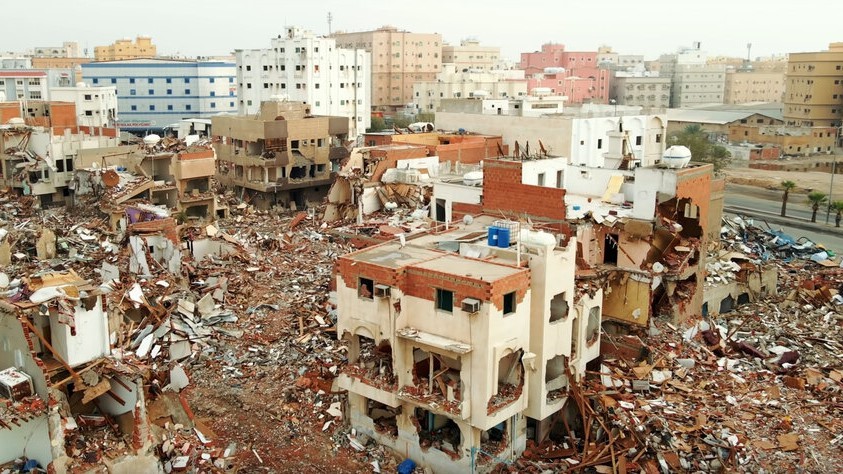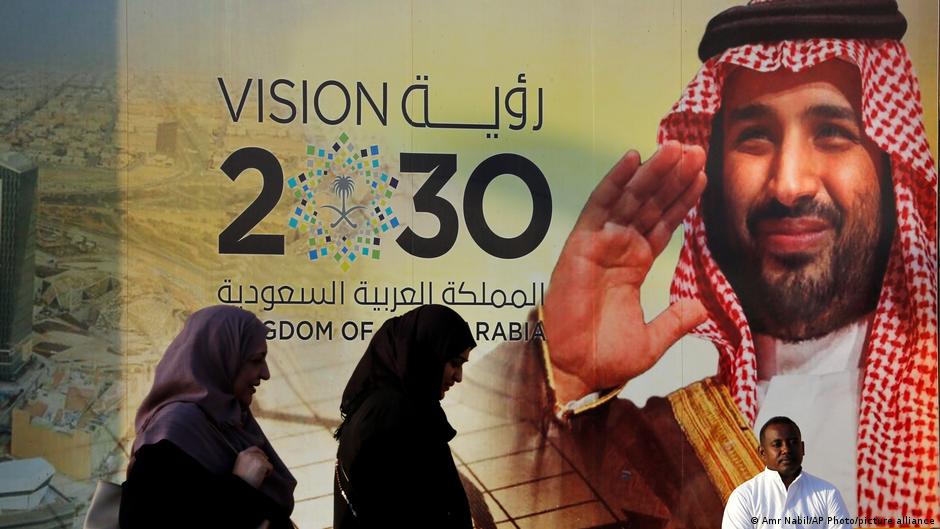The Crown Prince's bulldozers

Here and there, a minaret still rises into the air, a palm tree, even the remains of buildings still stand. Otherwise, the desert of rubble has a ghostly appearance, reminiscent of images from Syria or Libya. But there is no war in Jeddah, Saudi Arabia's second largest city. Bulldozers at the roadside show: here, the destruction was planned. Some call it destruction, others call it urban development.
Since October, massive demolition work has been underway in Jeddah's city centre. In once densely populated neighbourhoods such as Ghulail and Petromin, entire blocks of houses have been levelled. Apartments, garages, supermarkets, everything is flattened. Rubble piles up left and right of the streets. "Someone comes and writes 'eviction' on the wall of a building. Sometimes people have only a few weeks to clear their houses. In Ghulail, they had only 24 hours." This is how Khulud al-Harthi describes the authorities' approach to Qantara. The 26-year-old grew up in Kilo 14, a neighbourhood that could soon also be a thing of the past.
On Tiktok and Instagram, thousands of photos and videos of the wrecked cityscape are circulating under the keywords "destruction of Jeddah" and " slum clearance". For many, a cemetery in the Kandara district exemplified the radical approach of the authorities. As on other buildings, the word "eviction" suddenly appeared spray-painted in red letters on the wall of the cemetery building. Before the authorities could react, the images went viral on the web. Shortly afterwards, the city administration announced it was a mistake. There had never been any plans to remove the cemetery.
Currently, the areas most affected by the destruction are those to the south and east of the old city, the Balad, parts of which have been designated UNESCO World Heritage sites. Prior to evacuation, between 10,000 and 50,000 people lived in each of these neighbourhoods. That means tens of thousands are likely to lose their homes. Estimates circulated by dissidents and demolition critics range from hundreds of thousands to one million. When asked, neither the authorities responsible nor the Saudi embassy in Berlin would comment on the number of people affected.
"Victory over the slums"
Photographs, some taken from drones, give an idea of the scale: half of Ghulail and Petromin have been levelled, as have large parts of Mada'en Fahad, Nuzla Yamaniya, Qurayat and others. At the end of January, electricity and water were turned off in Kandara and Hindawiya to speed up evictions. Hindawiya now resembles a ghost town, ready for demolition.

The neighbourhoods around the Balad have been a bone of contention for years. The press, which has already proclaimed a "victory over the slums", deplored the "visual deformation" of the city; drug use and criminal activities were also alleged to be rife. A video released last week by the regional government to elicit understanding for the demolition shows filthy streets, wailing sirens and men with darker skin fleeing from police officers. According to a municipality document obtained by Qantara, 63 neighbourhoods, or nearly 40 percent of Jeddah's urban area, are considered ashwa'iyat: unplanned neighbourhoods or "slums" to be developed or removed.
Architect Atef Alshehri, however, rejects the term 'slums'. "These neighbourhoods have grown organically," he says, "they simply don't conform to the principles of modernist urban planning." Unlike in the north of Jeddah, with its rows of fancy restaurants, lower-income families lived in a ring around the Balad. Their ancestors came from the south of Arabia, migrated from the African continent, or came to the peninsula as slaves and made their home in settlements around Jeddah, then still a walled city. Others were on pilgrimage and settled permanently outside Jeddah, which served as a port city for Mecca, 80 kilometres away. It was only after the city walls fell in 1947, commercial oil production began in Saudi Arabia and more people moved into the cities, that the settlements around what is now the old city were wiped from the urban area.
Narrow streets, winding alleyways and partly unclear ownership still bear witness to the unplanned growth around the old city of Jeddah, Alshehri explains. As a city that has forwn up over time, old Jeddah may not look "sexy enough" to compete with globalised glass and steel architecture in Dubai, Singapore or Hong Kong, but it is unique, bursting with local identity and memories.
Under Mohammed bin Salman (MBS), Crown Prince since 2017, the alleged slums are being given short shrift. With his reform agenda "Vision 2030", he purports to be modernising the kingdom. He has silenced his detractors and centralised power; at the same time, he has built up a sovereign wealth fund worth hundreds of billions with which he hopes to attract investment and make the Saudi economy independent of oil. As part of a controlled opening up of the country, individual tourists have also been allowed to travel there since 2019. The ashwa'iyat in Jeddah, the country's potential showcase metropolis (Riyadh lies deep in the desert), do not fit the picture.
Space for a marina, beach resorts, shopping
In December, MbS personally gave the starting signal for the large-scale project "Jeddah Central". Unlike the new open spaces in the south and east, for which there are no known construction plans, a marina and beach resorts with shopping facilities are to be built on the Red Sea coast north of the old city, along with Saudi Arabia's first opera house, a sports stadium and an "Oceanarium". In addition, there will be 17,000 residential units, hotels and "integrated solutions for the corporate sector". An area significantly larger than Central Park in New York is to be re-developed here alone. The sovereign wealth fund has provided 18 billion euros in start-up financing to encourage private investors to get on board. One commentator enthused about a "New Jeddah".
"Nobody is against modernisation," says architect Alshehri, "these neighbourhoods are run down and criminality is high." But what is being built here will be void of local identity, he fears. Just look at the financial districts of Singapore, Hong Kong or Riyadh, he says: "The same thing is happening in Jeddah now. "Space is being produced by capital. The community is being replaced by master developers."
In well-informed circles, there are fears that a large part of the city's population will be driven into homelessness. How many families will be compensated is unknown. Those who can prove land ownership are supposed to get money for land and real estate – but these are likely to be in the minority: according to the municipality, documents are available for only 11 percent of the land in the ashwa'iyat. Moreover, the percentage of non-Saudis in the area is as high as 70 percent.
In January, the municipality published figures showing that 550 families had been temporarily resettled. A total of about 4,800 new housing units are still to be built this year. What will happen to those who cannot produce documents is unclear. "The assessment of their situation is ongoing", stated the municipality and implied that charitable organisations would pick up the slack.
However, not everyone in the ashwa'iyat is destitute. Architect Alshehri talks about an "exodus of people" flocking to Jeddah's rental and real estate markets. He fears both a rise in rents and an unhealthy boost to Jeddah's real estate market: "The influx of new buyers onto the market could create real estate speculation."
The demolition work has also drawn the attention of the opposition in exile. "They call it modernisation," says exiled opposition activist Ali AlAhmed on the phone from Washington, D.C. But in reality, land and houses are being bought up from people at discount prices or seized in exchange for modest compensation, just so that members of the royal family and their minions can build hotels. Jeddah is a continuation of what has long been a reality elsewhere: "If you look at Mecca and Medina, it's clear that historic neighbourhoods are being destroyed to build glass skyscraper towers", he says. "Mohammed bin Salman wants to turn Jeddah into something like Dubai."
© Qantara.de 2022